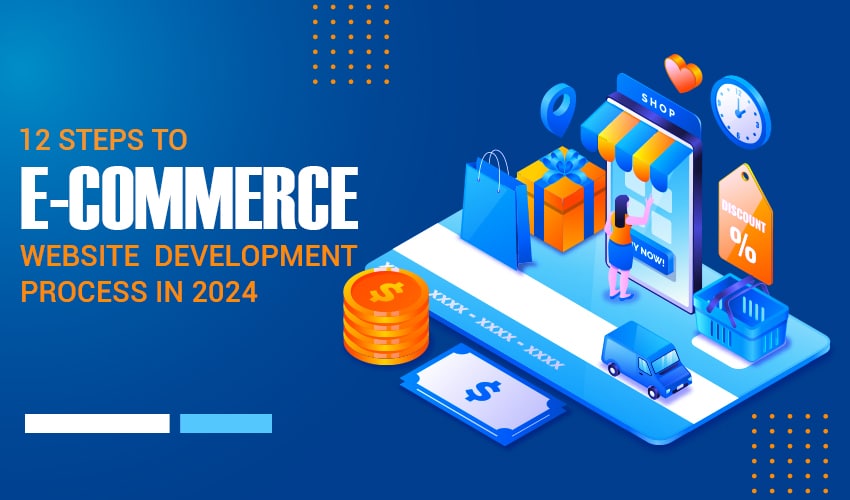The world of eCommerce has witnessed unprecedented growth in recent years, with online shopping becoming the norm for consumers worldwide. As we look ahead to 2024, the importance of a well-designed and efficient e-Commerce website cannot be overstated.
Whether you’re a seasoned eCommerce entrepreneur or a business owner just stepping into the online retail arena, it’s crucial to understand the eCommerce website development process to ensure success. In this comprehensive guide, we’ll walk you through the 12 essential steps of eCommerce website development in 2024.
1. Define Your Goals and Objectives
Every successful eCommerce project begins with a clear understanding of your goals and objectives. Are you looking to create a brand-new eCommerce site, redesign an existing one, or expand to new markets? Identify your target audience, revenue goals, and the features you need to achieve them. This will serve as your roadmap throughout the development process.
2. Market Research and Competitor Analysis
Market research and competitor analysis are vital steps in eCommerce website development. Understand your industry, your competition, and your target market. This knowledge will inform your design, content, and marketing strategies. Identify what makes your business unique and how you can stand out in a crowded marketplace.
3. Choose the Right eCommerce Platform
Selecting the right eCommerce platform is a critical decision. Popular choices in 2023 include Shopify, WooCommerce, Magento, and BigCommerce, among others. Each platform has its strengths and features, so choose the one that aligns with your business needs, scalability, and budget.
4. Design and User Experience (UX)
The design of your eCommerce website plays a pivotal role in attracting and retaining customers. Your site should be visually appealing, user-friendly, and responsive on various devices. Focus on a clean, intuitive design that enhances the user experience, with easy navigation, clear product listings, and a streamlined checkout process.
5. Development and Customization
This step involves building the actual website on your chosen platform. It includes setting up the eCommerce framework, integrating payment gateways, and customizing the design to align with your brand’s identity. Consider hiring experienced developers to ensure the site is technically sound and fully functional.
6. Content Creation
High-quality content is essential to engage and convert visitors into customers. Develop clear, concise product descriptions, attractive images, and informative videos. Use content marketing strategies, including blogs, videos, and social media, to create a strong online presence.
7. SEO Optimization
Search engine optimization (SEO) is crucial for eCommerce success. Optimize your site for search engines by using relevant keywords, creating descriptive meta tags, and ensuring fast load times. SEO is an ongoing process, so keep monitoring and refining your strategy.
8. Testing and Quality Assurance
Before launching your eCommerce site, thorough testing is essential. Check for any technical glitches, usability issues, and security vulnerabilities. Test the checkout process to ensure it’s seamless and secure. Ensure that your site performs well across different browsers and devices.
9. Security and Compliance
Security is a top priority for eCommerce websites in 2023. Implement strong security measures, including SSL certificates and regular security audits, to protect sensitive customer information. Ensure that your site complies with data protection regulations, such as GDPR and CCPA, to build trust with customers.
10. Launch and Marketing Strategy
Once your eCommerce website is thoroughly tested and secure, it’s time to launch. Develop a comprehensive marketing strategy that includes social media, email marketing, pay-per-click advertising, and content marketing. Leverage analytics tools to monitor the site’s performance, gather insights, and make data-driven decisions to improve conversions and sales.
11. Ongoing Maintenance and Optimization
Post-launch, the work doesn’t stop. Ongoing maintenance is crucial to ensure your eCommerce site remains up-to-date, secure, and efficient. Regularly update content, monitor site performance, and implement changes based on customer feedback and analytics. Continuously optimize your site for better user experience and conversion rates.
12. Customer Support and Feedback
Providing excellent customer support is essential for building trust and retaining customers. Implement a responsive customer support system and encourage customers to leave feedback and reviews. Use this valuable feedback to improve your website and the overall shopping experience.
The eCommerce website development process in 2024 will be a comprehensive journey that requires careful planning, design, and execution. It’s essential to stay updated with the latest industry trends, technologies, and customer expectations. By following these 12 steps, you can create a successful eCommerce website that not only meets your business goals but also provides an exceptional shopping experience for your customers. Remember that eCommerce is a dynamic field, and continuous adaptation and improvement are key to your ongoing success in the ever-evolving world of online retail.

